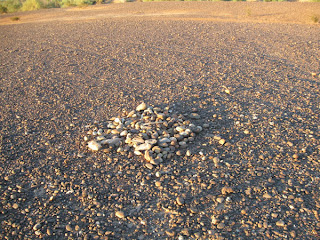Consider the “Maya Influence” on the world after
1492 for just a moment.
Take a look at: “10 Maya
foods that changed the world's eating habits,” for example. Christine Delsol
writes, “Lost among the laurels heaped upon the Maya, though, is credit for
their agricultural wizardry. When the conquering Spanish started carrying Maya
food staples back to Europe and to the Caribbean, Asia and Africa, it changed
the world's eating habits. We're not talking about the Yucatán's deliciously
exotic lime-and-achiote concoctions
but food you buy every day in Safeway's produce aisles…”
The ten foods listed are Avacados, Papaya, Squash,
Chocolate, Vanilla, Corn, Chiles, Tomatoes, Black Beans and Sweet Potatoes.
So back up for
just a moment and consider just the Maya influence on the “western half of the
world,” as we’ve been taught to think of it – and maybe it extends farther than
the above map suggests. “Ancient Maya cuisine,” reads the Wikipedia entry of the same title, “was
varied and extensive. Many different types of resources were consumed,
including maritime, flora,
and faunal material, and food was obtained or
produced through a host of strategies, such as hunting, foraging,
and large-scale agricultural production. Plant domestication focused on several core foods, the
most important of which was maize.
The two most common maize races of the Maya highlands are
Olotón (Left) and Comiteco (Right).
Much of the Maya food supply was grown in forest gardens, known as pet kot.[1] The system takes its name from the low
wall of stones (pet meaning
"circular" and kot "wall of loose stones") that
characteristically surrounds the gardens.
The Maya adopted a number of adaptive techniques that, if
necessary, allowed for the clear-cutting of land and re-infused the soil with
nutrients. Among these was slash-and-burn, or wideness, agriculture, a
technique that cleared and temporarily fertilized the area. For example, the
introduction of ash into the soil raises the soil’s pH,
which in turn raises the content of a variety of nutrients, especially phosphorus, for a short period of time of
around two years. However, the soil will not remain suitable for planting for
as many as ten years. This technique, common throughout the Maya area, is still
practiced today in the Maya region. Complementing wideness techniques were crop rotation and mil pafarming,
employed to maintain soil viability and increase the variety of crops.”
Maybe you were thinking of somewhere in what’s now called
North America as you read the words “forest gardens,” or “low stone walls”
described as “circular walls of loose stones.”
Three Sisters as featured on the reverse of the 2009 Native American
U.S. dollar coin
Wiki goes on to say, “Maya diet focused on four domesticated
crops (staple
foods): maize, squash, beans (typically Phaseolus
vulgaris) and chili peppers.
The first three cultivars are commonly referred to in North America as the "Three Sisters" and, when incorporated in a diet,
complement one another in providing necessary nutrients.[2] Among
the three, maize was the central component of the diet of the ancient Maya, and
figured prominently in Maya mythology and ideology.”
Maize? Isn’t that Corn? Maybe you were thinking you could say that was also
the central component of the diet of the Ancient People who were leaving all
those arrowheads and stuff around your neighborhood. I know they were in mine.
At Native Tech,Tara Prindle
writes about Maize in New England:“As the lifeways of mobile hunting and gathering were often transformed into sedentary agricultural customs, very slowly the cultivation of maize, along with beans and squash, was introduced into the southwestern and southeastern parts of North America. The practice of maize agriculture did not reach southern New England until about a thousand years ago.
Amazing Maize: The Science, History and
Culture of Corn
When: Sept. 24-March 24, 9 a.m.-5 p.m. 2013
Price: Free with museum admission.
It takes 25 corn plants
per person per day to support the American way of life. This 10,000-year global
genetic journey explores the relationship between people and corn, arguably the
most productive domesticated plant and the greatest plant breeding achievement
of all time. Visitors will be a-maized at the scientific, economic and cultural
significance and impact of corn on daily life, past and present.
For more info, visit www.indianamuseum.org.
For more info, visit www.indianamuseum.org.
Amazing Maize delivers a WOW experience from the
entryway's eye-popping 7-foot tall sculpture of corn products on through six
sections taking us across 10,000 years of evolution from wild plant in
Mesoamerica to today's genetically modified fields.
You can walk through and get the high points, or you can allow
yourself to become thoroughly engaged with interactives, including some of the
4,200 corn-based products currently available, American Indian tribal
relationships with corn featuring a larger-than-life replica of the Mayan corn
god, scientific findings and technological advancements highlighted by a chance
to climb aboard a tractor and manage thousands of acres of corn fields.
Built to feel like you're on a farm, there's a delightful
brightness in the delivery of information that makes you feel like you're in a
conversation. We start with "did you know it takes 25 corn plants per
person per day to support the American way of life - from sweeteners to
plastics, fuels to textiles, [M&Ms to baby powder], corn is a part of every
life for nearly all of us."
Journeying through 5,000 square feet of space we find out why and
how corn has remained the mainstay of human and animal life from its isolated
beginnings in the heart of Mexico to its current penetrating appearance
worldwide and out into space.
Amazement lurks around every corner - try pounding corn into meal
the old way, meet up with a razorback hog and figure out why corn whiskey was
an easier way to ship corn down the Ohio River. Make connections between
moonshine and the Indy 500; corn, overpopulation and African slave trade; and
corn and the discovery of vitamins. My ideal visit is to spend a day, with a
lunch break at the Ayer's dining room savoring their corn-ingredient foods.









































